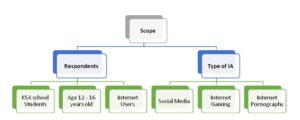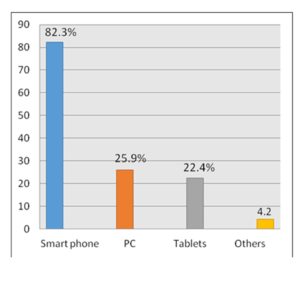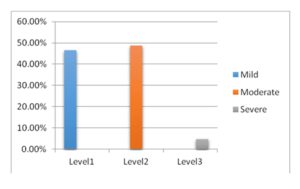Background
Statistically, the number of Internet users stood at about 40 percent of the 3,179,035,200 world population. The Middle East makes about 3.3 % of that population. By 2015, the total population of the Middle East is estimated to reach 236,137,235 with 48.1% being Internet users. The Kingdom of Saudi Arabia has the second highest population of Internet users (18 million) in the Middle East with Iran (46.8 million) boosting the highest (Internet Live Stats, 2015).
Although the Internet is often associated to having good development, it also brings along some ailment in the form of excessive use. On the extreme, the Internet can cause a negative kind of dependency or addiction.
The term Internet Addiction (IA), which has attracted much research, can be defined as the overuse of the Internet leading to impairment of an individual’s psychological state (both mental and emotional), as well as their scholastic, occupational, and social interactions (Tao et al. 2010; Young 1996;). The addiction bears similarities to substance dependency such as drug addiction and alcohol addiction. It is also likened to nonchemical addiction behaviour dependency which included pathological gambling, compulsive shopping, sex addiction, and eating disorders in the category of Fattore et al. (2014). Kimberly Young (1998), a well-known researcher in this field, describes Internet addiction as follows: “any online-related, compulsive behaviour which interferes with normal living and causes severe stress on family, friends, loved ones, and one’s work environment. Internet addiction has been called Internet dependency and Internet compulsivity. By any name, it is a compulsive behaviour that completely dominates the addict’s life.”
Another significant researcher in the area, Beard (2005) laid out five criteria for diagnosis of Internet addiction: preoccupation with the Internet; Needs to use the Internet with increased amounts of time in order to achieve satisfaction; Has attempted control, cut back, or stop Internet use but failed; Is restless, moody, depressed, or irritable when attempting to cut down or stop Internet use; and, has stayed online longer than originally intended. Additionally, an Internet addict possesses at least one of the following: Has jeopardized or risked the loss of a significant relationship, job, educational or career opportunity because of the Internet; Has lied to family members, therapist, or others to conceal the extent of involvement with the Internet; Uses the Internet as a way of escaping from problems or of relieving a dysphoric mood.
This research is motivated by the need to ensure that the Kingdom of Saudi Arabia is aware of the social risk that comes hand-in-hand with the benefits brought along by the Internet. The research feels that it is important that a continual survey is conducted to monitor the impact of the Internet to the youth of the country. Hence a survey was conducted and this paper aims at sharing the findings and proposed basic recommendations with regards to having a controlled and beneficial use of the Internet.
The subsequent sections explained the method and tool used by the research. This is followed by the findings and discussion. A conclusion of the research ends the paper.
Methodology
This research adopts a quantitative method using a questionnaire that is adapted from the work of Kimberly Young’s Internet Addiction Test (IAT). The IAT is seen as a valid tool due to the credibility of the creator: Dr Kimberly Young is an expert in the Cognitive-Behavioural Therapy for Internet. She is also the founder of the Centre for Internet Addiction which provides treatment for Internet addiction (http://netaddiction.com/).
Besides the original question from the work of Young, the questionnaire has included 5 additional questions which are aimed to assess the respondents’ use of social media and the impact of its use on their religious duties. The survey is translated into Arabic language which is suitable for the targeted Arabic speaking respondents. The survey was conducted in two phases: A pilot survey (which tests the questionnaire) followed by an actual survey (using the tested questionnaire). Analysis of the survey is performed by using SPSS software.
Survey Focus
The focus is scoped into three categories of use: Social Media, Internet Gaming, and Internet Pornography. The following Figure 1 explains the scope:

Figure 1: Survey Scope
Pilot Survey
The pilot survey was conducted on a group of 27 students aged 9 -15 years old with the aim of gauging the suitability of the questionnaire for young respondents. This takes into consideration the language (Arabic) and its level as well as the length (time duration) taken to complete a questionnaire. Based on the observation and findings of the pilot survey, modifications to the survey were made as follows: the age group was raised from 9-15 years old to 12-16 years old. This is based on the high number of spoilt responses from questionnaires filled by younger respondents. The use of yes-no responses instead of Likert-scale for some questions in the questionnaires
Actual Survey
This actual survey was conducted at schools in the cities of Al-Qassim, Al Dammam, Jazan, Jeddah, Makkah, and Riyadh with high Internet penetration in the KSA. It involved 425 students (respondents) aged from 12 to 16 years old. The result of the actual survey is central to this research and is presented and discussed in subsequent sections.
Results
The survey results are presented in 4 parts. Namely, the respondents profile, their usage pattern for each of the 20 IAD questions (Young, 1998), break-down of usage levels based on the 20 IAD questions (Young, 1998), and findings based on the 5 additional questions.
Profile of Respondents
The 425 respondents are further described by the demographic charts which categorized them by gender, city of residence, either middle or high school, and their Internet-based devices (see Figure 1 — 6):

Figure 2: Gender of Respondents

Figure 3: Cities of residence/school

Figure 4: Respondents’ Internet devices

Figure 5: Respondents’ school stage

Figure 6: IA among KSA students
Responses to Basic 20 IAD Question
Based on the first 20, 5-Likert-scale questions, the Kimberly Young IAD Test measures the level of addiction into 5: mild or average (20 — 49 points), moderate (50 —
79 points) and severe (80 — 100 points) level of Internet Addiction. Based on these measures, the numbers of the 425 respondents are categorized as in the following table
Table 1: Addiction Level based on Kimberly Young’s IAT

The usage pattern on the 20 questions based on the Kimberly Young IAD Test is shown by the frequency tables below:
Table 2: Usage Pattern based on Kimberly Young’s IAT

Effect of social media on religious obligations
The 5 questions involving social media and obligations were added to find if the use of social media has an effect on the behaviour of the respondents in performing religious duties. It also wishes to gain the view of respondents on the use of social media.
- Does the use of social media sites affect your performance of the obligatory prayers?
Table 3: Additional Question 1 “YES” or “NO”.

- Does it affect your use of Social Media sites on honouring one’s parents?
Table 4: Additional Question 2 “YES” or “NO”.

- Is affecting your use of Social Media sites to your thoughts and change your convictions?
Table 5: Additional Question 3 “YES” or “NO”.

Do you think that the use of Social Media sites is not useful, and a waste of time?
Table 6: Additional Question 4 “YES” or “NO”.

- Do you think that the use of Social Media sites is the means which may help to look at the viewer against Islamic morals as watching (movies and photos against)?
Table 7: Additional Question 5 “YES” or “NO”.

Discussion
Based on the findings presented above, a further analysis summed up the following:
Addiction level: Although the number of respondents falling into the “severe” category is low (4.7%), the number of “moderately” addicted (48.7%) is worrying. Moderately addicted respondents are suseptible to evolving into severe addicts. On the other hand, with proper guide, which involves education and change in life-style, the moderately addicted will be able to have control over their Internet use.
High Suseptible areas: From the 20 questions posed in the IAD, the following are the top 5 impacts extracted based on the number of respondents in level 4 and 5:
Poor time management from staying longer than intended (Q1 and Q16) and lose sleep (Q14) — 37.2%, 33.7%, and 25.8%. Additionally, Respondents have received complaints from others over the amount of time they spend on Social Media (Q5) — 24.2%
Performance/Productivity/Grades/school work suffers due to the amount of time respondents spend on Social Media (Q6 and Q8 ) — 18.9% and 19.7%
Habit of checking email before doing something else (Q7) — 34.6%
Respondent adopts negative manners (becomes defensive or secretive when asked about what they do on Social Media. Respondents resort to “snap, yell, or act annoyed” if bothered while using Social Media (Q9 and Q13) — 33.8% and 28%
Impacts on social, lifestyle, and relationship are expressed by: anticipating when to go on Social Media again (Q11) and feeling preoccupied with the Internet when off-line, or fantasize about being on-line (Q15) preferring time on Social Media over going out with others (Q19 ) — 31.7%, 38.6, 17.9%
Religious duties: The additional 5 questions were added to gauge impacts on basic values pertaining to religious obligation. These responses offer insight and provide some clues on the impact of the Internet and social media on a the country considered as strict in the religious responsibility. However, the research felt that the “Yes-or-No” responses may not be a fair indicator to reflect the responses. A likert-scale or a continuous likert-scale would have been more appropriate in gauging or quantifying individual attitude, opinion, or matters relating to behavioral research (Treiblmaier and Filzmoser, 2009). The result indicates:
36.2% of the respondents agreed that using social media sites does affect their performance of the daily five obligatory prayers. Although the percentage is relatively low compared to (63.8%) the respondents that feel that it has no affect, it is considered as negative in the sense that the duty is mandatory in the religion.
Parents seem to demand better attitude from their “respondent” children. A healthy percentage of 72.5% responded that the use of social media sites is not affecting them from listening to their parents’ speeches and looking after their needs. However, 26.8% (respondents who were not able to respond to their parents while they are using social media) can still be considered as a significant number.
46.1% of the respondents agree that the use of social media is able to affect their thoughts and convictions. The research feels that this gives very strong indication and motivation for the country to ensure that the content delivered through the Internet and social media are closely monitored. Perhaps, positive filtering or censorship can be considered as well as putting effort to create a wealth of beneficial content.
33.2% of the respondents agreed that social media are a waste of their time and are not useful. This negative perception by this group may be due to the perception that content delivered through the Internet and social media is of lesser value. Taken that the Internet is a neutral technology and that good or bad use is dependent on the user (Baase, 2013), perhaps contents that are more beneficial should be created. It is important that good use of technology be instilled in the youths. This negative perception may also be related to the next finding which finds that 58.1 % of the respondents perceived social media as a means to view unethical or unislamic videos and pictures.
Conclusion
By accomplishing the objective that was set forth, the research was able to offer insights and understanding on the condition of Internet addiction among the youth of the KSA. The survey found 4.7% of the respondents to be severe addicts. Although the prevalence of the addiction may not be as severe as reported by studies compiled by the TechAddiction (2016): Britain (18%), Greece (8.2) South Korea (10%), and China (6 -7%), the future situation may worsen. The survey has also found that the Internet use among its respondents does bear negative impact on their religious duties. However, the research felt that the method used in eliciting the responses related to religious duties offers very limited and constrained responses.
The research believes that proper monitoring and control should be in place to ensure an acceptable level of use of the Internet suitable to the culture of the KSA. There is a lot of potential for the research to be improved and expanded further. Amongst are: Expansion of scope to include respondents as young as 4 years old. This is in consideration that the use of Internet has been introduced to children at a very young age; Expansion of scope to include more specific profiles such as housewives, young executives, and college students; and Development of tools to gauge addiction that are suitable to younger respondents. This may include observations and case study. Additionally, the research hopes that further studies can be conducted to explore treatment strategies suitable to the culture of the country. This may include simple time management techniques to more aggressive intervention, depending on the severity of the cases.
Acknowledgments
We would like to express gratitude to the people who have helped in the implementation of the research: the schools administration, managers, and teachers for facilitating the survey; the respondents for their time to answer the questionnaires; and volunteers who have helped in the preparation, distribution and collection of the questionnaires.
References
- Al-hantoushi, M. and Al-abdullateef, S. (2014) ‘Internet addiction among secondary school students in Riyadh city, its prevalence, correlates and relation to depression: A questionnaire survey’. Int J Med Sci Public Health 3(1): 10-15.
- Baase, S. (2013) ‘A Gift of Fire: Social, Legal, and Ethical Issues for Computing Technology’ 4th Edition, Pearson.
- Beard, K. W. (2005) ‘Internet addiction: a review of current assessment techniques and potential assessment questions’, CyberPsychology & Behavior. Feb; 8(1): 7-14.
Publisher – Google Scholar
- Casha H., Raea C. D., Steela, A. H. and Winklerb, A. (2012),’ Internet Addiction: A Brief Summary of Research and Practice Current Psychiatry Reviews’, 8(4), 292-298.
- Conrad B. (2016) ‘Internet Addiction Statistics – Facts, Figures, & Numbers’. [Online], [Retrieved March 28, 2016], http://www.techaddiction.ca/internet_addiction_statistics.html
- Elenchick, L. A., Becker, T. and Moreno, M. A. (2012) ‘Assessing the psychometric properties of the Internet Addiction Test (IAT) in US college students’. Psychiatry Research 196(2—3): 296-301.
Publisher– Google Scholar
- Fattore, L., Melis, M., Fadda, P., Fratta, W. (2014) ‘Sex differences in addictive disorders’, Frontiers in Neuroendocrinology, 35(3), 272—284. [PubMed]
Publisher – Google Scholar
- Haghighi, B. T., Hanim. F, Othman. M, and Md Din. M. (2012) ‘A Study on Malaysian Internet Usage Pattern’.
- Internet Live Stats (2016) Internet Users. [Online], [Retrieved March 28, 2016], http://www.internetlivestats.com/internet-users/
- Kapahi, A., Ling, C. S., Ramadass, S. and Abdullah, N. (2013) ‘Internet addiction in Malaysia causes and effects’.
- Stats, I. W. (2014) ‘Internet World Status Usage and Population Statistics’. [Online], [Retrieved March 28, 2016], http://www.Internetworldstats.com/asia/my.htm.
- Tao, R., Huang, X., Wang, J., Zhang, H., Zhang, Y. and Li, M. (2010) ‘Proposed diagnostic criteria for internet addiction’. Addiction 105(3): 556-564.
Publisher – Google Scholar
- Treiblmaier, H. and Filzmoser, P. (2009) ‘Benefits from using continuous rating scales in online survey research’, Institut f. Statistik u. Wahrscheinlichkeitstheorie
- Young, K. S. (1996) ‘Internet addiction: The emergence of a new clinical disorder’104th annual meeting of the American Psychological Association, August 11,Toronto, Canada.
15. Young, K. S. (1998) ‘The center for on-line addiction – frequently asked questions’. Center for On- Line Addictions.















